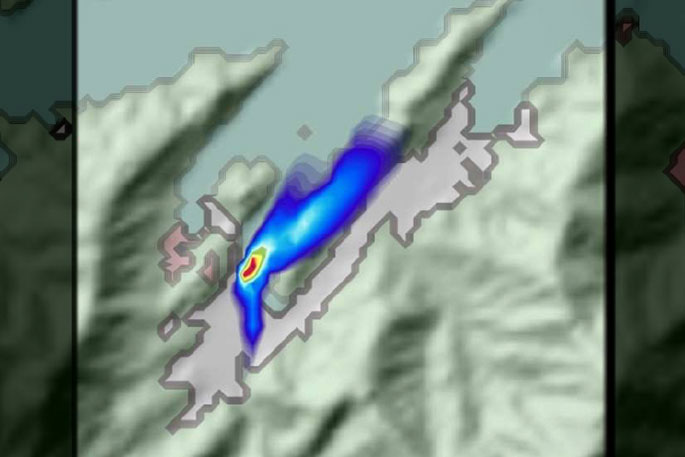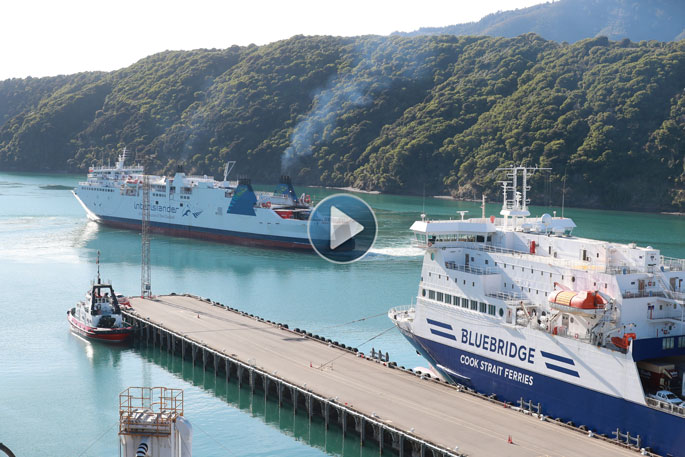A sensor on Picton's foreshore picks up about the same amount of sulphur dioxide in the air as a sensor does outside the Port of Tauranga.
In fact, it often picks up more sulphur dioxide, a gas that occurs naturally in volcanoes. It also comes from burning coal or diesel.
Port Marlborough exported about 770,000 tonnes of logs last year from Shakespeare Bay, near Picton. Last year, the Port of Tauranga exported 6.3 million tonnes of logs. In that sense, it's about eight times larger than Port Marlborough.
So why the similar levels of the harmful gas? Likely the thick clouds of white smoke blowing onto Picton from the inter-island ferries.
That's according to a new study, which basically echoes what residents have been saying for years.
The study was presented to the Marlborough District Council's environment committee last week, prompting councillors to call for an airshed in Picton, so its air quality could be monitored long-term. Marlborough's only existing airshed was in Blenheim.
The council decided to run a 14-month study to see what 'significant pollutants of concern” were blowing around Picton after residents became increasingly worried that the fumes from visiting ships were badly affecting their health.
It set up three sensors – one on the foreshore, one on the main road into town, and one at the local high school – to track sulphur dioxide, nitrogen dioxide, carbon monoxide and air pollution.
 Picton residents have for years worried about the effects of shipping emissions on their health. CREDIT: SCOTT HAMMOND/STUFF/SUPPLIED.
Picton residents have for years worried about the effects of shipping emissions on their health. CREDIT: SCOTT HAMMOND/STUFF/SUPPLIED.
Each pollutant could cause human health problems ranging from shortness of breath and coughing to asthma attacks, bronchitis, cardiovascular and respiratory diseases, or premature death.
The risk was higher among vulnerable people such as children, asthmatics or the sick. The study ran from July 2019 to August 2020.
The worst offender was found to be sulphur dioxide.
The team of air scientists analysing the data said the foreshore looked to have higher sulphur dioxide levels on average than New Zealand's largest port, in Tauranga. However, the ports did have different recording devices, weather patterns, types of visiting vessels, and traffic levels.
'The consistently higher baseline in the foreshore data is most likely associated with the regular ferry movements as opposed to freight vessels which remain alongside for longer periods,” the report said.
World-wide studies had shown that shipping emissions impacted the air quality of adjacent coastal areas, 'adversely affecting the local environment and human health”, the scientists said.
'It is not only while the ferry is at its berth that emissions occur, but also while it is arriving and leaving. Exhaust emissions can be clearly visible along Queen Charlotte Sound for some considerable time after a ferry has left its berth and is travelling towards Wellington, similarly when ferries arrive in the [Marlborough] Sounds from Wellington.”
Council environmental scientist Sarah Brand said it was 'interesting” to see a similar sulphur dioxide pattern, given Tauranga's port was 'substantially bigger” than Picton's port.
Interislander executive general manager Walter Rushbrook said KiwiRail welcomed the findings, and were working to enure its ferries reduced any impact on Picton's air quality.
He said KiwiRail was in the process of switching its Interislander ferries to cleaner-burning diesel oil, while it waited on its larger, greener ferries to be built and delivered.
The new diesel oil would reduce sulphur emissions.
'Longer-term, the Interislander is bringing in two new ferries, one in 2025 and one in 2026. These ferries will reduce the Interislander's emissions by 40 per cent overall compared to existing vessels and eliminate emissions while in port when they will run on battery or shore power,” Rushbrook said.
Bluebridge was approached for comment.
The report showed the amount of sulphur dioxide in the atmosphere stayed mostly within safe breathing levels through spring and summer, before suddenly skyrocketing in May last year on the foreshore and on the main road into town.
This led to multiple breaches of New Zealand's air quality laws. By the end of the study, Picton had come close to or gone over the limit once every five days.
Scientists were unsure what had caused the 'steep increase” going into winter, but Brand thought it indicated that scores of Picton residents were still using coal to heat their homes. The council did not know how many homes in Picton had coal burners.
Results also showed that nitrogen dioxide – an emission produced from fossil fuels – was stronger around the foreshore than on the main road into town, which scientists said was 'unexpected”, because it was exposed to less traffic.
 Scientists found light winds could blow pollution particles from the ferry terminal up to two kilometres away. The red area (around the terminal) indicates a high concentration of pollution particles. CREDIT: NIWA/SUPPLIED.
Scientists found light winds could blow pollution particles from the ferry terminal up to two kilometres away. The red area (around the terminal) indicates a high concentration of pollution particles. CREDIT: NIWA/SUPPLIED.
The emissions were particularly high in summer – not enough to crack public health guidelines, but close enough for scientists to conclude this could happen in the future.
'A possible explanation for the summer increase is the increase in use of local boats powered by diesel fuel in the harbour immediately adjacent to the foreshore site, and there is a fuel wharf in the area. However, further investigation would be required to confirm this hypothesis.”
Each of the senors also logged a jump in pollution at the end of spring, around the same time that wattle and pine trees began dropping their pollen, which carpeted the town yellow.
Brand told councillors last week that the study proved Picton was in danger of breaching national air quality laws for pollution particles, sulphur dioxide and nitrogen dioxide.
'There needs to be more work done on the sources of the contaminants, how they behave, how they move around.”
Several councillors were surprised by the findings. Councillor Gerald Hope said the study indicated that something needed to be done 'sooner rather than later”.
'If not for the wind, we'd probably have more complaints.”



2 comments
Hmmm
Posted on 14-10-2021 17:24 | By Let's get real
Much as we all rush out to clear supermarket shelves in a perceived crisis, should we now all book a trip on a ferry before the greenies ban them...? How is it a story if scientists are unsure, surprised or are just guessing.? You only need check out the local weather forecast to see how accurate some of our science based predictions are.
Anybody
Posted on 14-10-2021 21:42 | By The Caveman
that has lived on Picton for the past 50 years knows full well what the cause of the AIR pollution in the Picton basin is - the various ferries that use the basin, burning CHEAP and DIRTY heavy fuel oil !!!
Leave a Comment
You must be logged in to make a comment.